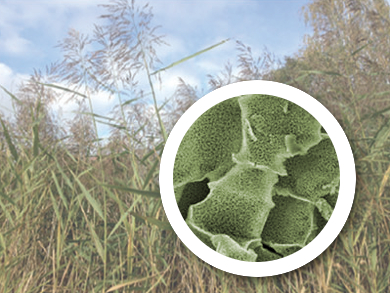Exploiting Silica Structures in Reed Leaves
The distinct structural and water-repellant properties of common reeds have been used by mankind for ages, for example as construction materials and for thatching roofs. How the micro- and nanostructured silica arrangements that are abundantly present in natural reed leaves can be exploited for producing the anode materials in lithium-ion batteries has recently been explored by Chinese and German scientists and is published in the journal Angewandte Chemie.
Nanoporous Silicon as an Electrode Material in Lithium-Ion Batteries
Nanoporous silicon is believed by many to be the next-generation anode material in lithium-ion batteries as it offers the benefit of a much higher theoretical capacity and lower operating voltage than the commonly used graphitic carbon materials. The big challenge, however, is finding a suitable low-cost strategy to employ an appropriate nanostructured silicon material that would compensate for the large volume expansion upon lithium insertion.
A truly distinct approach from the elaborate physical or chemical treatments of expensive silicon precursors has been explored by Yan Yu and her colleagues at the Max Planck Institute for Solid State Research, Stuttgart, Germany, the University of Science and Technology of China, Hefei, and the South China University of Technology, Guangzhou. The scientists imagined that the hierarchical architecture of the silica already present in the leaves of common reed plants can readily transform into the micro- and nanoporous silicon architecture required for lithium-ion battery materials.
Retaining the Reeds’ Silicate Network
“Reed leaves exhibit well-defined sheetlike 3D hierarchical microstructures,” the reseachers point out, “which can be transformed into highly porous 3D hierarchical silicon architectures by magnesiothermic reduction.” This magnesiothermic reduction was combined with a simple carbon-coating step to eventually achieve an anodic material exhibiting high specific capacity, very good rate capability, and cycling stability, just as it is required in advanced lithium-ion batteries.
What is particularly interesting here is that the topological architecture of the original silicates within the reed leaves is extraordinarily well preserved during the applied chemical and physical treatment steps. Upon purification from the dry reed leaves, the three-dimensional structure shrinks, but retains its mesoporous network. It does not even change during the reduction to the final carbonized silicon network. This robustness in structure preservation makes reed plants, which grow as large monocultures in the wetlands of temperate regions, especially suitable as a new, sustainable feedstock for battery materials.
- Energy Storage Materials from Nature through Nanotechnology: A Sustainable Route from Reed Plants to a Silicon Anode for Lithium-Ion Batteries,
Jun Liu, Peter Kopold, Peter A. van Aken, Joachim Maier, Yan Yu,
Angew. Chem. Int. Ed. 2015.
DOI: 10.1002/anie.201503150



